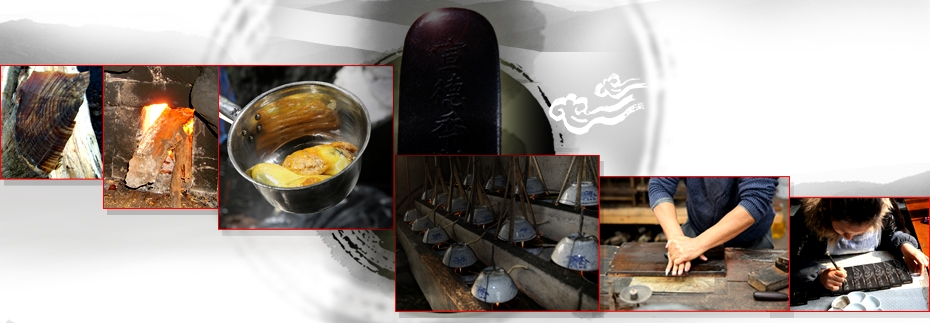
Traditional Hui Inkstick Craftsmanship
Splendid
Chi Culture
Topic
Traditional Hui Inkstick Craftsmanship
Inksticks are one of the “four treasures of the scholar’s studio,” and the ones crafted in Huizhou are considered unique treasures among traditional Chinese inksticks. The invention of the inkstick is a great contribution to the Chinese culture or even the world civilization. In May 2006, the State Council included the crafting of Hui inksticks among the first group of items on the List of the Intangible Cultural Heritage of the People’s Republic of China.
Inksticks have been made in China since no later than the Spring and Autumn period (770–476 BCE). Only a brief description of ink use survives from the small number of pre-Qin (times before 221 BCE) documents that have been excavated. Abundant documentation appears after the Han dynasty (206 BCE–220 CE) and our knowledge of inkstick manufacturing has increased accordingly.
Xi Chao (n.d.) of the late Tang dynasty (ca. late ninth century) created the Hui inkstick. Later, during the Five Dynasties (907–960), Li Tinggui (d. 967) manufactured ink that became very well-known. Shezhou (in modern Anhui province) became an important site for inkstick manufacturing beginning in the Northern Song dynasty (960–1127). Emperor Huizong (r. 1100–1125) changed the name of the town to Huizhou, and thus the Hui inkstick was born. As the influence of Huizhou merchants rose during the Ming dynasty (1368–1644), the Huizhou inkstick industry reached its peak. In the Qing dynasty (1644–1911), the industry continued to grow and three schools of inkstick making formed: Shexian, Jixi, and Wuyuan. On account of their fame, inkstick makers Cao Sugong (1615–1689), Wang Jie’an (n.d.), Wang Jinsheng (n.d.), and Hu Kaiwen (1742-1808) were called the “Four Major Inkstick Makers of the Qing.” Even today, “Hui ink” is a synonym for “inkstick.”
After the fall of the Qing dynasty, the region declined, the people lived in dire poverty and the Hui inkstick industry was unable to recover. It was not until after the 1950s that the industry gradually revived. Since 2005, China has been fully committed to protecting her intangible cultural heritage. Included among the first group of inscriptions on the list was the manufacturing of Hui inksticks. Since then, the industry has brimmed with vitality. A number of modern craftsmen have been recognized both at the provincial and the national level for their fine work.
The manufacturing of inksticks involves a number of complicated procedures, each requiring its own special materials and processes. First, by a special firing process, a high-quality pine soot made from branches with a high resin content is made. Pine soot was the earliest raw material used for ink making and, even today, it is the most common. Making large quantities of pine soot requires numerous pine trees. The tree’s growth cycle is long and slow, and this limits the availability. Lampblack, which emerged next, solved this problem to a certain extent.
In addition to pine soot (and lampblack), glue is the other major ingredient—there is as much glue in an inkstick as there is soot. The glue is make from the skin and bones of domestic animals such as oxen, donkeys, horses, and pigs. Although the traditional skills needed to make glue this way still survive, most of the glue used in modern inksticks is produced in modern chemical factories.
There are also several supplementary materials used to produce fine ink. These include musk, clove (Syzygium aromaticum L.), bear gall, pig gall, spikenard (Nardostachys jatamansi), patchouli, ash bark, gardenia kernel, indigo, lacquer, gold foil, cinnabar, orpiment, and others. They were used to scent the ink, give it special color and luster, and to preserve it.
The making of Hui inksticks involves many processes some of which are preparing the glue, combining the materials into a mixture, putting the mixture into molds, and tamping it down. The last step is packaging, which helps to maintain the inkstick’s quality and protect against moisture. Exquisite and unique packaging can also increase sales.
Some people have summarized the characteristics of the Hui inkstick thus, “it is light when it is picked up, it is clear when it is ground, it is fragrant when smelled, it is as hard as jade and makes no noise when it is being ground, a drop (of the ink) is like the lacquer, it preserves purity (retains its color) forever.”



